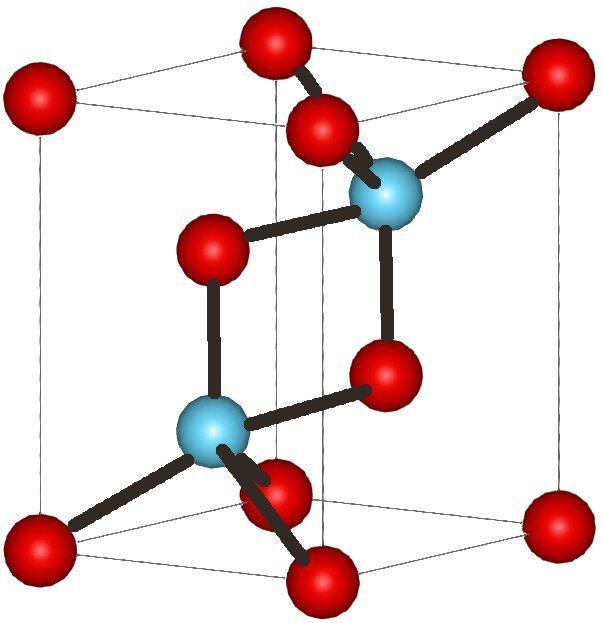Formula U2N3 Density 11.3 g/cm³ Appearance crystalline solid | Molar mass 518.078 g/mol Melting point 900 °C | |
 | ||
Uranium nitride meaning
Uranium nitride refers to a family of several ceramic materials: uranium mononitride (UN), uranium sesquinitride (U2N3) and uranium dinitride (UN2). The word nitride refers to the −3 oxidation state of the nitrogen bound to the uranium.
Contents
- Uranium nitride meaning
- Carbothermic reduction
- Sol gel
- Ammonolysis
- Hydriding nitriding
- Decomposition
- Uses
- Uranium nitrido derivatives
- References
Uranium nitride has been considered as a potential fuel for nuclear reactors. It is said to be safer, stronger, denser, more thermally conductive and having a higher temperature tolerance. Challenges to implementation of the fuel include a complex conversion route from enriched UF6, the need to prevent oxidation during manufacturing and the need to define and license a final disposal route.
Carbothermic reduction
The common techniques for generating UN is carbothermic reduction of uranium oxide (UO2) in a 2 step method illustrated below.
3UO2 + 6C → 2UC + UO2 + 4CO (in argon, > 1450 °C for 10 to 20 hours) 4UC + 2UO2 +3N2 → 6UN + 4COSol-gel
Sol-gel methods and arc melting of pure uranium under nitrogen atmosphere can also be used.
Ammonolysis
Another common technique for generating UN2 is the ammonolysis of uranium tetrafluoride. Uranium tetrafluoride is exposed to ammonia gas under high pressure and temperature, which replaces the fluorine with nitrogen and generates hydrogen fluoride. Hydrogen fluoride is a colourless gas at this temperature and mixes with the ammonia gas.
Hydriding-nitriding
An additional method of UN synthesis employs fabrication directly from metallic uranium. By exposing metallic uranium to hydrogen gas at temperatures in excess of 280 °C, UH3 can be formed. Furthermore, since UH3 has a lower specific volume than the metallic phase, hydridation can be used to physically decompose otherwise solid uranium. Following hydridation, UH3 can be exposed to a nitrogen atmosphere at temperatures around 500 °C, thereby forming U2N3. By additional heating to temperatures above 1150 °C, the sesquinitride can then be decomposed to UN.
2U + 3H2 → 2UH3 2UH3 + 1.5N2 → U2N3 U2N3 → UN + 0.5N2Use of the isotope 15N (which constitutes around 0.37% of natural nitrogen) is preferable because the predominant isotope, 14N, has a not insignificant neutron absorption cross section which affects neutron economy and, in particular, it undergoes an (n,p) reaction which produces significant amounts of radioactive 14C which would need to be carefully contained and sequestered during reprocessing or permanent storage.
Decomposition
Each uranium dinitride complex is considered to have three distinct compounds present simultaneously because of decomposing of uranium dinitride (UN2) into uranium sesquinitride (U2N3), and the uranium mononitride (UN). Uranium dinitrides decompose to uranium mononitride by the following sequence of reactions:
4UN2 → 2U2N3+ N2 2U2N3 → 4UN +N2Decomposition of UN2 is the most common method for isolating uranium sesquinitride (U2N3).
Uses
Uranium mononitride is being considered as a potential fuel for generation IV reactors such as the Hyperion Power Module reactor created by Hyperion Power Generation. It has also been proposed as nuclear fuel in some fast neutron nuclear test reactors. UN is considered superior because of its higher fissionable density, thermal conductivity and melting temperature than the most common nuclear fuel, uranium oxide (UO2), while also demonstrating lower release of fission product gases and swelling, and decreased chemical reactivity with cladding materials. It also has a superior mechanical, thermal and radiation stability compared to standard metallic uranium fuel. The thermal conductivity is on the order of 4-8 times higher than that of uranium dioxide, the most commonly used nuclear fuel, at typical operating temperatures. Increased thermal conductivity results a lower thermal gradient between inner and outer sections of the fuel, potentially allowing for higher operating temperatures and reducing macroscopic restructuring of the fuel, which limits fuel lifetime.
The uranium dinitride (UN2) compound has a face-centered cubic crystal structure of the calcium fluoride (CaF2) type with a space group of Fm3m. Nitrogen forms triple bonds on each side of uranium forming a linear structure.
α-(U2N3) has a body centered cubic crystal structure of the (Mn2O3) type with a space group of Ia3 .
UN has a face centered cubic crystal structure of the NaCl type. The metal component of the bond uses the 5f orbital of the uranium but forms a relatively weak interaction but is important for the crystal structure. The covalent portion of the bonds forms from the overlap between the 6d orbital and 7s orbital on the uranium and the 2p orbitals on the nitrogen. N forms a triple bond with uranium creating a linear structure.
Uranium nitrido derivatives
Recently, there have been many developments in the synthesis of complexes with terminal uranium nitride (–U≡N) bonds. In addition to radioactive concerns common to all uranium chemistry, production of uranium nitrido complexes has been slowed by harsh reaction conditions and solubility challenges. Nonetheless, syntheses of such complexes have been reported in the past few years, for example the three shown below among others. Other U≡N compounds have also been synthesized or observed with various structural features, such as bridging nitride ligands in di-/polynuclear species, and various oxidation states.
